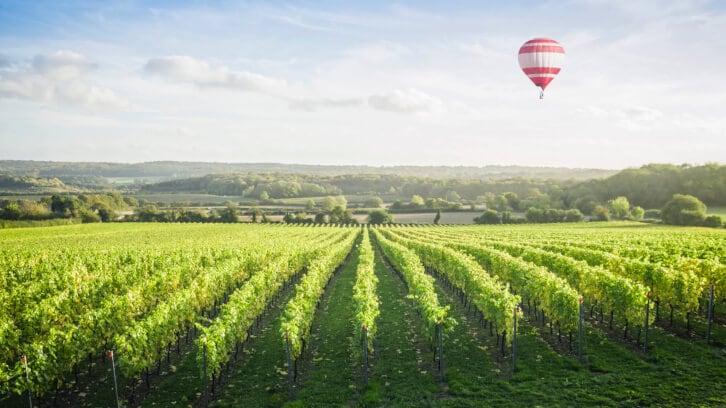A new report from the industry, released last month, uses most robust set of data ever recorded for the industry, according to WineGB, with over 90% of all production covered by the survey’s respondents.
That data marks a 'coming of age' for WineGB - the national association for the English and Welsh wine industry - giving it the base to make better decisions to enhance and grow wine production and sales at home and beyond.
Wine production
England and Wales – not traditionally considered as strong wine growing nations – are seeing opportunities to grow their wine industries.
Changing climate are threatening traditional wine producing territories; but also making conditions in the UK more favorable. Meanwhile, British consumers are demanding more local, environmentally friendly products.
Viticulture is one of the UK’s fastest growing agricultural sectors. There are currently 3,928 hectares under vine in Britain, up 74% in five years. The majority of this is in the south counties of Kent (26% of total plantings), West Sussex (15%) East Sussex (13%), Hampshire (10%) and Essex (8%).
This area is project to reach around 7,600ha by 2032.
The industry employs around 2,300 full time workers, with predicted 50% growth by 2025 and a further 8,000 employed in seasonal or part time work.
In 2022, total production was 12.2 million bottles. This is expected to rise to 25 to 29 million bottles by 2032 (mid-range predictions). The majority is white wine (62% of still wines and 78% of sparkling), followed by rose (21% of still and 22% of sparkling).
So what's driving growth? The key selling points of the region's wine, according to WineGB, is that it is high quality, sustainable and - for the domestic market - local and widely available. For overseas markets, the image of British quality and craftsmanship also play into the equation.
And highlighting these attributes have proven to be 'very effective' in promoting and growing the industry, says WineGB.
"Consumers are much more tuned into local/British products as a serious option when making their purchasing choices. Recent years have seen plenty of coverage putting spotlight put on wines from Britain by leading influencers.
Chardonnay is the most-planted grape variety, covering 31% of total plantings. Pinot Noir accounts for 29%, Pinot Meunier accounts for 9% and Bacchus 8%.
"Working with the trade to highlight the category has also been really positive and yielded some excellent results. Many of our brands have developed great relationships with the trade which has had a very positive knock on effect.
"From an industry perspective continuing to promote the category through media and social media and through our events and activities also serves to highlight our wines and vineyards to as wide an audience as possible.
"We are also lucky to have exceptional goodwill from everyone around us, it seems the desire to make English/Welsh wine goes beyond our producers and WineGB."
Challenges for the industry
Keeping up this momentum will be key for the industry moving forward, says WineGB. The organization sets out its mission as 'ensuring the future growth and prosperity of our members and the industry' - whether this be through education & training, working with government and regulatory authorities, developing trade opportunities, making wines and vineyards sustainable, driving R&D, and collecting data to help inform future strategies.
Communicating the idea of value is one of the top priorities.
"While awareness is growing, we need to try and understand and communicate regionality better. One thing we are doing here is using our awards to identify winemaking and style trends across the country," says the organization.
And the famously temperamental English weather is another challenge for the industry.
"Climate will always be a challenge, as it is for most other norther European regions. This is evidenced in the report where still sales are down is because it was not a great year for growing grapes and therefore for producing still wines. The challenge shifts from perpetually trying to ripen grapes in a marginal climate to managing the swings in yearly weather patterns."
Wine tourism provides big boost
Like other wine regions worldwide, English and Welsh vineyards have found a lot of opportunity in building wine tourism.
Income from wine tourism now equates, on average to 24% of total revenue (this covers sales, tours and other onsite activity). Visitor numbers are up 17% on 2021 (based on WineGB’s Tourism survey).
The biggest 25 producers account for 83% of total sales.
The off trade accounts for 41% of sales, exports account for 7%, on-trade accounts for 22%, and D2C sales (whether online or from the cellar door) account for 30%.
“As the effects of Covid-19 wear off, purchasing habits have changed. This can be seen in the reduction of direct-to-consumer sales and growth in on- and off-trade accounts.”
But wine tourism is important not only for the income it brings.
"Wine tourism has huge potential to engage with more consumers and drive the category, both domestically and with inbound tourists," says WineGB.
Outside tourism, there are also opportunities to continue to grow vineyard area and production.
"There are still potential sites that are ideal for viticulture. We now have an ever-growing range of expertise who can work with those coming in to the industry on suitability for viticulture, winemaking, business planning and placemaking to ensure that as we expand we remain committed to the vision of producing to high quality in whatever we do."

